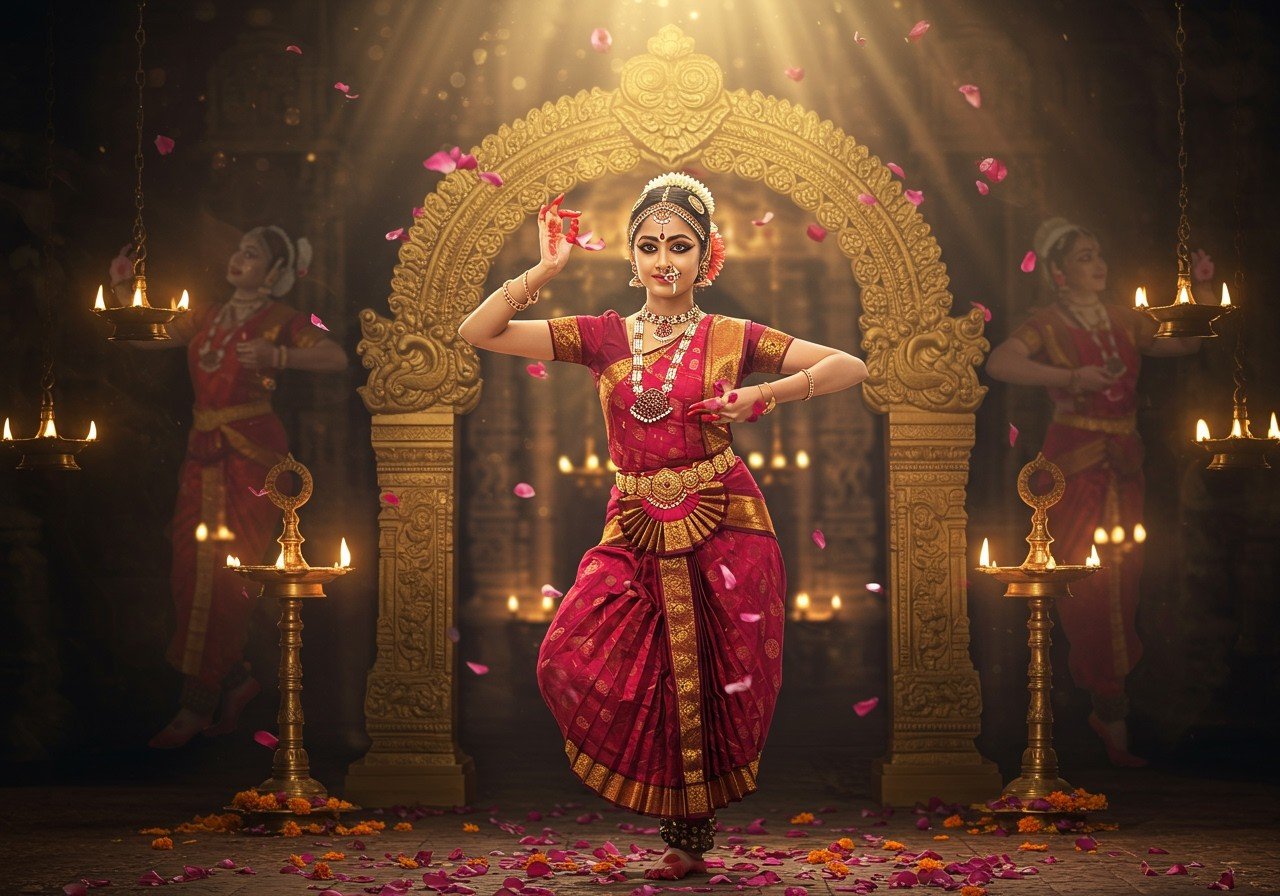
Bharatanatyam, a classical Indian dance form, is renowned for its elegance and deep cultural heritage. At its heart lies the Pushpanjali, a time-honored floral offering that commences every performance. This blog delves into the profound meaning of Pushpanjali, illuminating its origins, significance, and integral role in this timeless art form.
Understanding the Essence of Pushpanjali
Derived from the Sanskrit words “Pushpa” (flower) and “Anjali” (offering with folded hands), Pushpanjali in Bharatanatyam is a reverential invocation, a gesture of respect to the divine, the Guru, and the audience. It’s a symbolic commencement, a gesture of devotion and surrender that sets the spiritual tone for the entire recital. The dancer’s skilled hand gestures (mudras) and intricate footwork, performed to a measured rhythm, deepen the engagement with this sacred ritual.
Pushpanjali: A Tamil Nadu Perspective
In Tamil Nadu, where Bharatanatyam flourishes, Pushpanjali, known as ‘புஷ்பாஞ்ஜலி,’ holds immense cultural value. It’s a powerful expression of gratitude and reverence, often accompanied by verses from ancient Tamil literature, reflecting the region’s rich literary traditions. Regional nuances in music and costumes add a unique flavor, enriching the understanding of Bharatanatyam’s profound cultural depth. You can explore more about the rich traditions of bhajans and kirtans on our blog.
The Melody of Devotion: Pushpanjali Songs
The selection of a Pushpanjali song is crucial, as it sets the mood for the entire performance. Compositions by renowned poets like Swathi Thirunal and Papanasam Sivan, often in ragas like Hamsadhwani or Nattai, evoke a deep sense of devotion. The lyrics, rich with praise for the deities and expressions of humility, blend seamlessly with the dancer’s movements, creating a harmonious experience.
Pushpanjali’s Place in a Bharatanatyam Recital
Traditionally, Pushpanjali inaugurates a Bharatanatyam performance, creating an atmosphere of reverence and anticipation. It acts as both a warm-up for the dancer and a gentle invitation for the audience to enter the sacred space. This simple yet powerful act highlights the dancer’s expressive abilities (abhinaya), conveying profound emotions through subtle gestures and expressions. It is an offering of surrender to the divine, establishing a spiritual connection that resonates throughout the performance.
Cultural Significance and Lineage
Deeply rooted in tradition, Pushpanjali transcends mere dance; it’s a sacred ritual. The offering of flowers symbolizes devotion and a commitment to preserving the art form’s integrity. Its presence in religious festivals and auspicious occasions further underscores its ritualistic importance. For dancers, mastering Pushpanjali is a significant milestone, signifying their readiness for more complex performances and fostering a sense of community within the shared lineage of Bharatanatyam. More on the importance of offerings can be found in our blog post about sacred offerings in Hindu rituals.
Honoring the Divine and the Guru
Pushpanjali in Bharatanatyam is a tribute to Lord Nataraja, the divine patron of dance, seeking blessings for a successful recital. It’s also a gesture of respect to the Guru, the musicians, and the audience. With folded hands, the dancer offers flowers, real or symbolic, conveying reverence and gratitude. This act aims to dispel obstacles and invite positive energy, creating a sacred connection between the performer and the audience.
A Spiritual Communion
With grace and reverence, Pushpanjali opens the Bharatanatyam recital, setting a spiritual tone that invites the audience to connect with the divine. The simplicity of the offering amplifies the dancer’s expressive prowess, conveying emotions through nuanced gestures and expressions (abhinaya). This embodiment of surrender to the divine creates a sacred space, fostering a profound connection between the performer, the audience, and the spiritual realm.
Poojn.in: Your Partner in Sacred Rituals
Need the perfect items for your Pushpanjali? Poojn.in offers a wide selection of traditional and authentic puja items, including fresh flowers, delivered right to your doorstep across India. Explore our range of rose petals, brass flower baskets, camphor, cotton wicks, diyas, sandalwood powder, and incense sticks. We ensure quality, purity, and timely delivery so you can focus on your art. Consider our baran dala sets and kumkum and roli for a truly traditional Pushpanjali.
Embracing Pushpanjali: A Deeper Understanding
Pushpanjali is more than just the start of a performance; it’s the beginning of a journey into the heart of Bharatanatyam’s rich traditions. As dancers embrace this sacred offering, they honor the past and pave the way for future expressions of this beautiful art form. By appreciating and understanding Pushpanjali, you become a part of a timeless tapestry woven with devotion, art, and community.
Common Questions about Pushpanjali
What is Pushpanjali in Bharatanatyam? Pushpanjali is a traditional dance offering of flowers to the gods, performed at the beginning of a Bharatanatyam recital to seek blessings and set a spiritual tone. It’s a beautiful blend of graceful movements and symbolic gestures.
Why is Pushpanjali important? Pushpanjali is crucial as it serves as a salutation to the divine, allowing dancers to center themselves spiritually before their performance. It shows respect to the guru, musicians, and audience, creating a shared sacred space.
What is the Tamil meaning of Pushpanjali? Pushpanjali translates to “flower offering” in Tamil, combining “Pushpam” (flower) and “Anjali” (offering). This reflects the deep connection between the offering and the reverence it represents in Tamil culture.
Are there specific songs for Pushpanjali? Yes, popular Pushpanjali songs often feature traditional rhythms and melodies, invoking devotion. Choosing the right song sets the mood and adds to the spiritual atmosphere of the performance.
How is Pushpanjali performed? Pushpanjali incorporates graceful hand gestures (mudras) and footwork, creating beautiful patterns while offering flowers (real or symbolic) to honor the divine. The dancer’s expressions convey deep reverence.
Can beginners perform Pushpanjali? Absolutely! Pushpanjali’s elegance and simplicity make it suitable for dancers of all levels, from beginners to seasoned performers. It’s a fundamental element of Bharatanatyam.
Is Pushpanjali always performed? While not strictly mandatory, Pushpanjali is traditionally the opening act in most Bharatanatyam recitals, setting the stage for the performance and establishing the sacred ambiance.
Do male dancers perform Pushpanjali? Yes, both male and female dancers perform Pushpanjali. It’s a universal offering of respect and devotion, not limited by gender.


